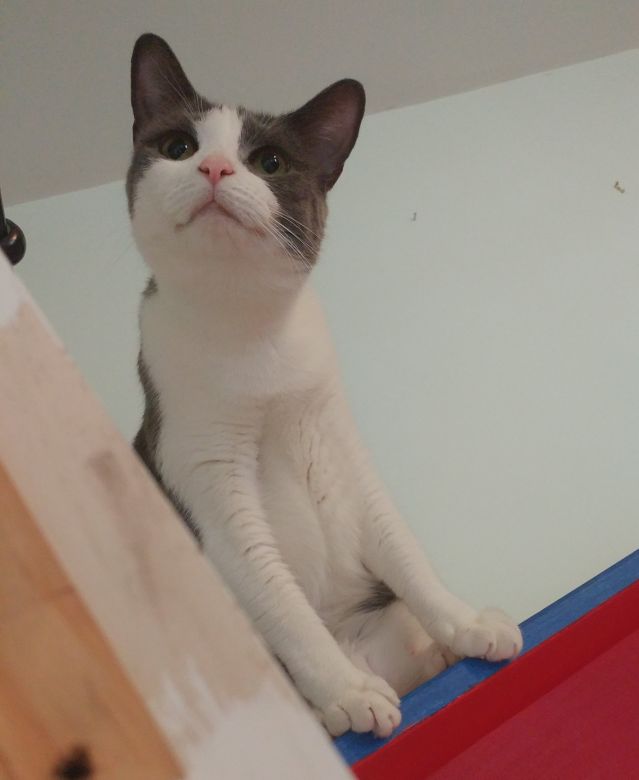Cognition
Cats Get the Point of Pointing
Some cats understand what a human means when they point to an object.
Posted April 24, 2023 Reviewed by Vanessa Lancaster
Key points
- Researchers tested cats’ responses to two types of human pointing gestures—direct pointing and cross-body pointing.
- Cats chose to approach the object a human experimenter pointed towards significantly more than chance.
- The results show that cats can use human communicative cues like dogs and some other domesticated species.

Pointing is a unique human referential signal. Babies develop the ability to understand pointing gestures between the ages of nine and 12 months. But what about the nonhuman animals with whom we spend our lives?
Scientists have found that a range of domestic animals, including goats, pigs, horses, and, most prominently, dogs, can follow human pointing signals. However, despite being one of the most numerous pets on the planet, relatively little research has investigated social-cognitive abilities like this in cats.
That’s one reason Claudia Wascher at Anglia Ruskin University took up the question in a new study in the Journal of Comparative Psychology.
“This study came about because a student, Margaret Mäses, approached me and said she would like to test cats,” says Wascher. “I was absolutely up for it because cats are an interesting and understudied species.”
Wascher and Mäses set out to replicate and expand on a study from nearly 20 years ago showing that cats may be able to follow human pointing gestures.
To find subjects, Mäses meticulously evaluated the suitability of approximately 200 rescue cats housed together in a shelter in Lithuania. Out of these cats, she worked to identify those who were open to being isolated in the testing room with a stranger.
“I do have to credit Margaret, who was absolutely brilliant in being able to identify individuals who were not fearful or anxious and were interested in taking part in the study,” says Wascher.
Out of the 200 cats at the shelter, Wascher and Mäses ended up with a sample of nine cats who completed testing. Why so few?
“One of the problems was that so many of the cats were not interested in the test or in being isolated in the room or in whatever this strange human wanted from them,” says Wascher. “In cognitive tests like these, it is important that the subject know what question is being asked of them and they are motivated to take part in the experiment.”
Uncovering Cat Cognition
For those cats that were amenable to being tested, Mäses presented them with two cups, each containing a small amount of food. She tested the cats in two conditions: one in which she pointed directly at one of the cups and one in which she pointed across her body at one of the cups.

Overall, the results showed that cats are able to follow human pointing gestures. As a group, the cats’ success rate was about 75 percent, and they performed significantly above chance whether the pointing gesture was direct or across the body.
While this replicates and expands on the previous study, Wascher said further research is needed to understand this behavior's underlying mechanisms. For instance, local or stimulus enhancement are forms of social learning in which the attention of an observer is drawn to a particular place or object by the activity of a demonstrator. In the case of cats, Wascher says it would be interesting to see if the demonstrator or stimulus drawing the cats’ attention to a particular food cup must be a human. In other words, would a nonliving object pointing toward a container also influence the cats’ choice?
Studies like these are also interesting from an evolutionary perspective. Neither domestic cats nor their ancestors use pointing gestures to communicate. Has the process of domestication selected for social-cognitive abilities that allow cats today to communicate better with humans? It’s an open question for now.
Wascher said this study also adds to the growing body of literature suggesting that species not typically thought of as highly social may still be able to master social-cognitive tasks. Even though cats usually do not live in huge, socially sophisticated groups, socialization with humans may give them a chance to exhibit their social-cognitive abilities.
Finally, Wascher hopes research like this will help cat owners better understand the behavior and cognition of the animals in their care.
“For a long time in science, the cognitive abilities of other species were underestimated,” she says. “I think a better understanding of how other animals think and feel creates an environment where humans tend to be more careful with them.”
References
Mäses, M., & Wascher, C. A. F. (2023). Assessing cats’ ( Felis catus ) sensitivity to human pointing gestures. Journal of Comparative Psychology, 137(1), 38–44. Doi: 10.1037/com0000338.
Miklósi A, Pongrácz P, Lakatos G, Topál J, Csányi V. A comparative study of the use of visual communicative signals in interactions between dogs (Canis familiaris) and humans and cats (Felis catus) and humans. J Comp Psychol. 2005 May;119(2):179-86. doi: 10.1037/0735-7036.119.2.179.




